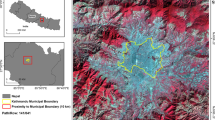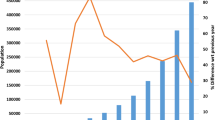Abstract
Rapid and unplanned expansion of a city into its eco-sensitive areas like hills, wetlands, and forests is becoming a major concern, particularly in developing countries. Understanding the process and causes of such unplanned urban expansion is of paramount importance for framing sustainable urban development policies. This paper presents a modelling concept that relates urban settlement in such eco-sensitive areas with potential socio-economic, demographic and geographical factors. The model is applied to an Indian city Guwahati, which is experiencing serious environmental degradation due to unplanned urban settlement in its eco-sensitive hilly areas. While topographical and settlement data were derived using satellite data in GIS platform, all other necessary data were collected from relevant government organizations. On validation of the multi-linear regression model, the coefficient of determination and the root mean square error are obtained as 0.938 and 1.7, respectively. Model results show that geographical parameters are less influencing as compared to the other socio-economic and demographic factors. Sensitivity analysis of urban settlements in hills of Guwahati city carried out with respect to the considered factors reveals that land value and free space availability in the surrounding area of a hill are the most sensitive parameters. This indicates that city development plans should give more importance to outward spatial expansion in plain areas with regulated land value and zoning scheme to minimize unauthorized settlement in eco-sensitive hilly areas of Guwahati city.

Data source: Census of India (no census could be conducted in Guwahati in 1981)

Source: GMC





Similar content being viewed by others
References
Acharjee, S., Goswami, U., & Saikia, R. (2013). Visual change detection study of some of the urban areas of Assam, India using remote sensing. International Journal of Geomatics and Geosciences, 3(3), 500.
Ajibola, M. O., Adewale, B. A., & Ijasan, K. C. (2012). Effects of urbanisation on Lagos wetlands. International Journal of Business and Social Science, 3(17), 310–318.
Amoako, C., & Cobbinah, P. B. (2011). Slum improvement in the Kumasi metropolis, Ghana: A review of approaches and results. Journal of Sustainable Development in Africa, 13(8), 150–170.
Amoateng, P., Cobbinah, P. B., & Owusu-Adade, K. (2013). Managing physical development in peri-urban areas of Kumasi, Ghana: A case of Abuakwa. Journal of Urban and Environmental Engineering, 7(1), 96–109.
Bierwagen, B. G., Theobald, D. M., Pyke, C. R., Choate, A., Groth, P., Thomas, J. V., et al. (2010). National housing and impervious surface scenarios for integrated climate impact assessments. Proceedings of the National Academy of Sciences of the United States of America, 107(49), 20887–20892.
Bird, S., Harrison, J., Exum, L., Alberty, S., & Perkins, C. (2002). Screening to identify and prevent urban storm water problems: Estimating impervious area accurately and in expensively. In Proceedings of the national water quality monitoring council conference, Madison, Wisconsin.
Borthakur, M., & Nath, B. K. (2012). A study of changing urban landscape and heat island phenomenon in Guwahati metropolitan area. International Journal of Scientific and Research Publications, 2(11), 1–6.
Brockerhoff, M. (2000). An urbanising world. Population Bulletin, 55(3), 3–43.
Chabaeva, A. A., Civco, D. L., & Prisloe, S. (2004). Development of a population density and land use based regression model to calculate the amount of imperviousness. In Proceedings of ASPRS annual conference. Denver, Colorado.
Clarke, K. C., & Gaydos, L. J. (1998). Loose-coupling a cellular automaton model and GIS: Long term urban growth prediction for San Francisco and Washington/Baltimore. International Journal of Geographical Information Science, 12(7), 699–714.
Cobbinah, P. B., & Darkwah, R. M. (2016). African urbanism: the geography of urban greenery. Urban Forum, 27, 149–165.
Cobbinah, P. B., Erdiaw-Kwasie, M. O., & Amoateng, P. (2015). Africa’s urbanisation: Implications for sustainable development. Cities, 47, 62–72.
Darkwah, R. M., & Cobbinah, P. B. (2014). Stewardship of urban greenery in an era of global urbanisation. International Journal of Environmental, Ecological, Geological and Geophysical Engineering, 8(10), 671–674.
Desai, R., Mahadevia, D., & Mishra, A. (2014). City Profile: Guwahati. CUE Working Paper 24, Centre for Urban Equity (CUE). http://cept.ac.in/UserFiles/File/CUE/Working%20Papers/Revised%20New/24%20City%20Profile%20Guwahat.pdf, as browsed on 18th June, 2015.
Dumitru, T. (2012). The impact of tourism development on urban environment. Studies in Business and Economics, 7(3), 160–165.
European Environment Agency. (2002). Toward an urban atlas: Assessment of spatial data on 25 European cities and urban areas. Copenhagen: Environmental Issue Rep. 30, EEA.
Exum, L. R., Bird, S. L., Harrison, J., & Perkins, C. A. (2005). Estimating and projecting impervious cover in the southeastern United States. Athens: Ecosystems Research Division, National Exposure Research Laboratory, U.S. EPA.
Gadgil, M., Daniels, R. J. R., Ganeshaiah, K. N., Prasad, S. N., Murthy, M. S. R., Jha, C. S., et al. (2011). Mapping ecologically sensitive, significant and salient areas of Western Ghats: Proposed protocols and methodology. Current Science, 100(2), 175–182.
GMDA. (2009). Master plan of Guwahati metropolitan area 2025. Guwahati Metropolitan Development Authority, Guwahati. http://www.gmda.co.in/master_plan.php as browsed on 28th October 2015.
Goetz, S., Jantz, C. A., & Sun, M. (2011). Forecasting future land use and its hydrologic implications: A case study of the upper Delaware River watershed. Watershed Science Bulletin, 2(2), 18–26.
Graham, P. H., Costello, L. S., & Mallon, H. J. (1974). Estimation of imperviousness and specific curb length for forecasting stormwater quality and quantity. Journal (Water Pollution Control Federation), 46(4), 717–725.
Henderson, V. (2003). The urbanization process and economic growth: The so-what question. Journal of Economic Growth, 8, 47–71.
Hussain, M., & Phanjoubam, P. (2007). Status report on displacement in Assam and Manipur. Kolkata: Mahanirban Calcutta Research Group. http://www.mcrg.ac.in/pp12.PDF.
Ichimura, M. (2003). Urbanization, urban environment and land use: Challenges and opportunities. In Meeting conducted at Asia-Pacific forum for environment and development expert, Guilin. People’s Republic of China.
Jedwab, R., Christiansen, L., & Gindelsky, M. (2015). Demography, urbanization and development: Rural push, urban pull and…urban push? policy research working paper. The World Bank Group.
Jim, C. Y. (2004). Green-space preservation and allocation for sustainable greening of compact cities. Cities, 21(4), 311–320.
Lee, L. (1979). Factors affecting land use change at the urban–rural fringe. Growth and Change, 10, 25–31.
Liu, Y., Nie, L., Wang, F., & Nie, Z. (2015). The impact of tourism development on local residents in Bama, Guangxi, China. Tourism Economics, 21(6), 1133–1148.
McDonald, R. I., Forman, R. T. T., & Kareiva, P. (2010). Open space loss and land inequality in United States cities, 1990–2000. PloS One, 5(3), e9509, 1–7.
Mensah, C. A. (2014). Urban green spaces in Africa: Nature and challenges. International Journal of Ecosystem, 4(1), 1–11.
Otis, T. (2012). Evaluating SLEUTH model accuracy at different geographic scales around two National Parks. Graduate Research Project, Shippenburg University. http://webspace.ship.edu/cajant/documents/white_papers/otis_2012_sleuth.pdf.
Oueslati, W., Alvanides, S., & Garrod, G. (2014). Determinants of urban sprawl in European. Urban Studies, 52(9), 1594–1614.
Preston, S. H. (1979). Urban growth in developing countries: A demographic reappraisal. Population and Development Review, 5(2), 195–215.
Prisloe, M., Wilson, E.H., & Arnold, C. (2003). Refinement of population-calibrated land-cover-specific impervious surface coefficients. Final report. NEMO FY’02 Work Plan DEP Project 01–08 Task #6. University of Connecticut Middlesex County Extension Center.
Rahman, G., Alam, D., & Islam, S. (2008). City growth with urban sprawl and problems of management for sustainable urbanization. In 44th ISOCARP congress. http://www.isocarp.net/data/case_studies/1203.pdf.
Ramachandra, T.V., & Mujumdar, P.P. (2009). Urban floods: Case study of Bangalore. Disaster and Development, 3 (2), 1–97. http://wgbis.ces.iisc.ernet.in/energy/water/paper/urbanfloods_bangalore/profile.htm.
Sarma, B. (2011). Optimal ecological management practices for controlling sediment and water yield from a hilly urban system within sustainable limit. PhD. dissertation submitted to centre for the environment, Indian Institute of Technology Guwahati.
Sarma, B., Sarma, A. K., Mahanta, C., & Singh, V. P. (2015). Optimal ecological management practices for controlling sediment yield and peak discharge from hilly urban areas. Journal of Hydrologic Engineering, 20(10), 04015005-1–04015005-14.
Stankowski, S. J. (1972). Population density as an indirect indicator of urban and suburban land-surface modifications. US Geological Survey Professional Paper, 800-B, B219–B224.
Sultana, M. S., Islam, G. T., & Islam, Z. (2009). Pre- and post-urban wetland area in Dhaka City, Bangladesh: A remote sensing and GIS analysis. Journal of Water Resource and Protection, 1, 414–421.
Tan, P. Y., Wang, J., & Sia, A. (2013). Perspectives on five decades of the urban greening of Singapore. Cities, 32, 24–32.
Theobald, D. M. (2005). Landscape patterns of exurban growth in the USA from 1980 to 2020. Ecology and Society, 10(1), 32. https://www.ecologyandsociety.org/vol10/iss1/art32/.
Theobald, D. M., Goetz, J. S., Norman, J. B., & Jantz, P. (2009). Watersheds at risk to increased impervious surface cover in the conterminous United States. Journal of Hydrologic Engineering, ASCE, 14(4), 362–368.
UNDESA/PD. (2012). World urbanisation prospects: The 2011 revision. New York: United Nations.
United Nations. (2001). The components of urban growth in developing countries (ESA/P/WP.169). New york: United Nations.
United Nations (2013b). World economic and social survey: sustainable development challenges (E/2013/50/Rev. 1 ST/ESA/344), Newyork. https://sustainabledevelopment.un.org/content/documents/2843WESS2013.pdf.
Veldkamp, A., & Fresco, L. O. (1996). CLUE: A conceptual model to study the conversion of land use and its effects. Ecological Modelling, 85, 253–270.
Verburg, P. H., Veldkamp, W. S. A., Espaldon, R. L. V., & Mastura, S. S. A. (2002). Modelling the spatial dynamics of regional land use: The CLUE-S model. Environmental Management, 30(3), 391–405.
Author information
Authors and Affiliations
Corresponding author
Rights and permissions
About this article
Cite this article
Patowary, S., Sarma, A.K. Model-based analysis of urban settlement process in eco-sensitive area of developing country: a study with special reference to hills of an Indian city. Environ Dev Sustain 20, 1777–1795 (2018). https://doi.org/10.1007/s10668-017-9965-1
Received:
Accepted:
Published:
Issue Date:
DOI: https://doi.org/10.1007/s10668-017-9965-1




